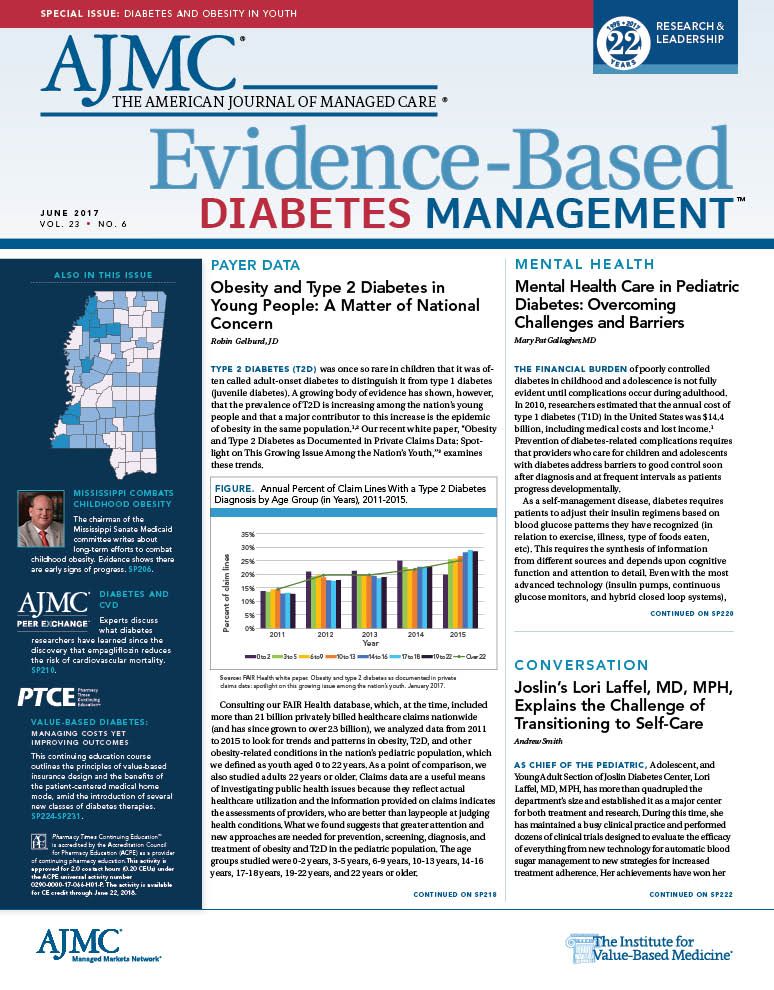- Center on Health Equity & Access
- Clinical
- Health Care Cost
- Health Care Delivery
- Insurance
- Policy
- Technology
- Value-Based Care
Understanding What the Young Person With Diabetes Needs
From the Editor-in-Chief
When we talk about the rising prevalence of diabetes in youth, those outside medicine often assume we are referring to type 2 disease (T2D). Certainly, T2D and coincident obesity are rising at alarming rates; T2D in youth was rare a generation ago, but today, the effects of sedentary lifestyles, too much screen time, and poor nutrition are evident. Old assumptions about what constitutes healthy eating for children are being set aside. A good example is the recent editorial by my colleagues here at Joslin Diabetes Center—Heather A. Ferris, MD, PhD; Elvira Isganaitis, MD, MPH; and Florence Brown, MD—called for an end to juice in the Special Supplemental Nutrition Program for Women, Infants, and Children.1
Within this issue of Evidence-Based Diabetes Management™ we discuss results from the first decade of the SEARCH study, which has found an increase in diabetes among youth. But it is not just T2D; type 1 diabetes (T1D), which gets less attention, is on the rise, too, and it is increasing among populations not historically associated with the disease.2 SEARCH also showed us that youth are developing complications of diabetes at younger ages. These trends raise many new questions that ongoing studies will explore, according to Barbara Linder, MD, PhD, of the National Institutes of Health.3
Support for Psychosocial Care
In this issue, Mary Pat Gallagher, MD, of NYU Langone Medical Center, outlines the rising cost burden ($14.4 billion in 2010) of T1D, but as she explains, it is the psychosocial toll that demands greater attention, both from the diabetes care team and from the health system. As Gallagher discusses, the American Diabetes Association has brought attention to this aspect of the diabetes burden—and it is a burden—by endorsing a position statement on the providing high-quality psychosocial care that meets individual patient needs. Psychosocial care is not widely available and not accessed enough, in part because it is poorly reimbursed. Support for people living with diabetes must be ongoing through all of life’s stages.
The Promise of Technology
Is there hope in better insulin pumps, improved continuous glucose monitors (CGMs), and the promise of an artificial pancreas? Of course, there is. Better tools and apps are wonderful, but they can also be overwhelming and burdensome, especially at first. As my colleague Lori Laffel, MD, MPH, shares in this issue, it is essential to manage expectations. Young adults may not always seek more information. Technology only helps if it is used (or if insurance companies pay). Clinical trials have shown us that CGMs are effective when used—but adherence in young people is often limited, and we need to understand why that happens.
Finally, there is the challenge of diabetes care for young people that can never come from an app, a gadget, or a pill. Learning to take responsibility for one’s own care, to help parents let go, and to be the person asking questions at the doctor’s appointment, is perhaps the most difficult part of learning to live with T1D. Evidence tells us this period is the time when young people with T1D have the worst glycemic control. Joslin and other health systems have programs for youth to help transition from pediatric to adult care, but these programs need to be more robust and ubiquitous. Our payment systems must support interaction on digital platforms—because this is what youth want.
For all the new tools that we have in diabetes care, the most important one for helping young people is the most basic: our ability to listen.
References
1. Ferris HA, Isganaitis E, Brown F. Time for an end to juice in the special supplemental nutrition program for women, infants, and children [published online April 24, 2017]. JAMA Pediatr. doi: 10.1001/jamapediatrics.2017.0134.
2. Mayer-Davis EJ, Lawrence JM, Dabelea D, et al. Incidence trends of type 1 and type 2 diabetes among youths, 2002-2012. N Engl J Med. 2017;376(15):1419-1429. doi: 10.1056/NEJMoa1610187.
3. Rates of new diagnosed cases of type 1 and type 2 diabetes on the rise among children, teens [press release]. Bethesda, MD: NIH newsroom; April 13, 2017. www.nih.gov/news-events/news-releases/rates-new-diagnosed-cases-type-1-type-2-diabetes-rise-among-children-teens. Accessed May 26, 2017.

Exploring Pharmaceutical Innovations, Trust, and Access With CVS Health's CMO
July 11th 2024On this episode of Managed Care Cast, we're talking with the chief medical officer of CVS Health about recent pharmaceutical innovations, patient-provider relationships, and strategies to reduce drug costs.
Listen
Integrated Care for Chronic Conditions: A Randomized Care Management Trial
December 3rd 2025The authors sought to understand the differential impact of payer-led community-based care management approaches on stakeholder-oriented outcomes for publicly insured adults with multiple chronic conditions.
Read More

